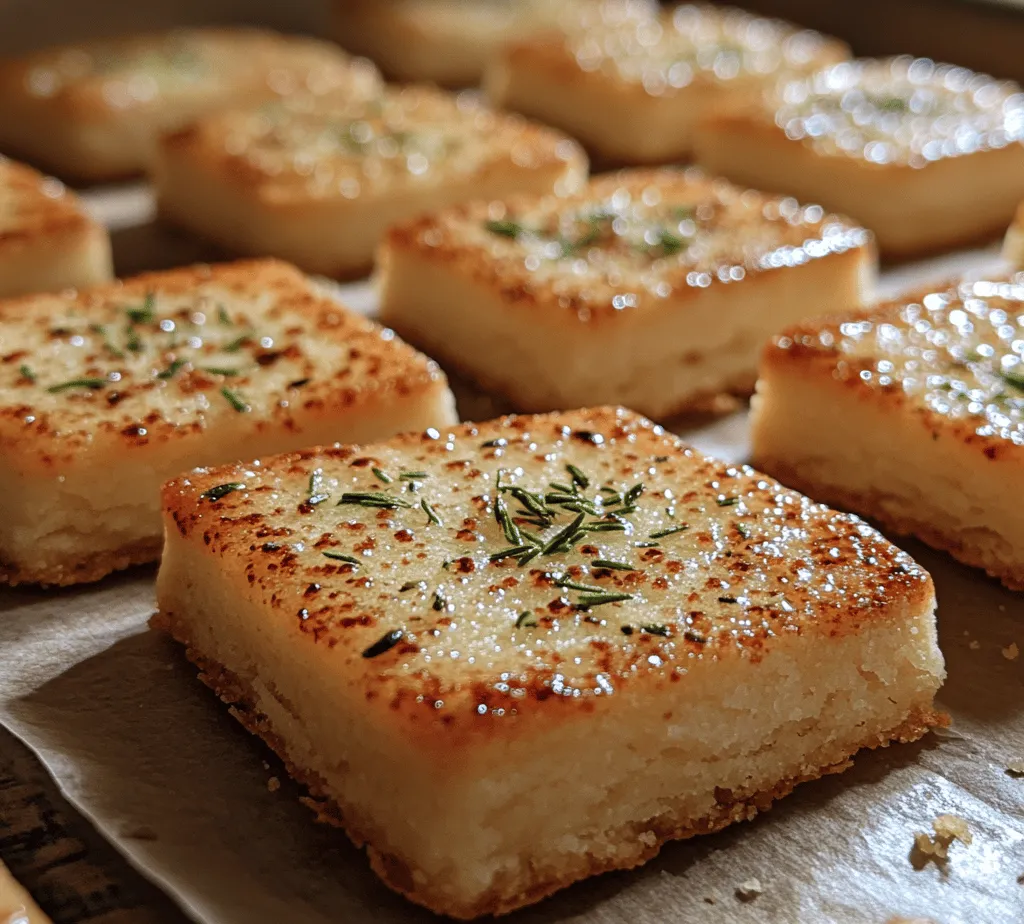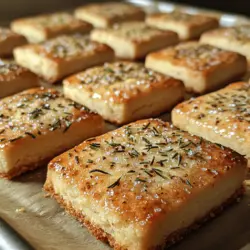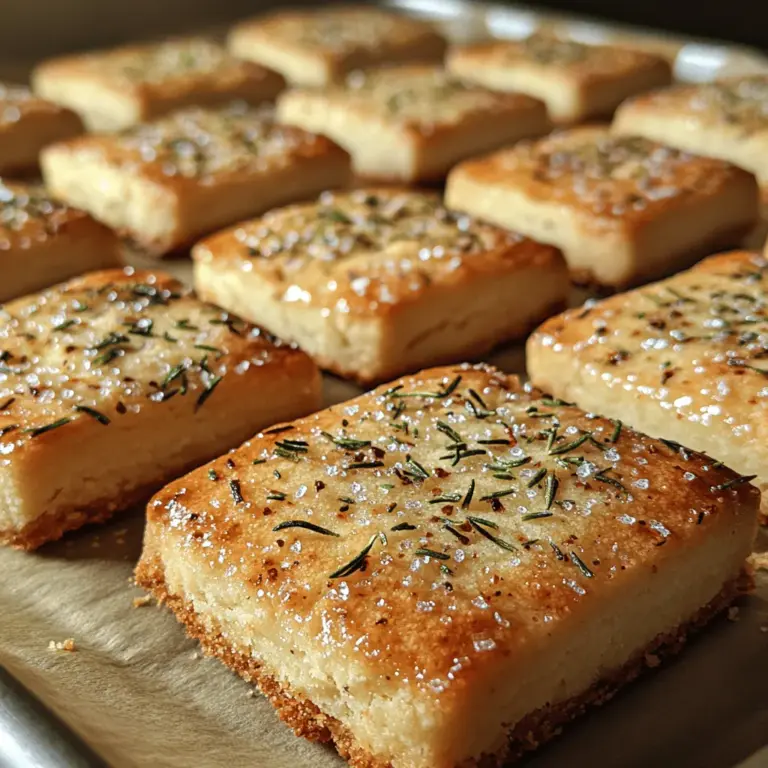Shortbread cookies have long been cherished for their rich, buttery flavor and crumbly texture. Their simplicity is what makes them such a beloved treat, often evoking memories of cozy afternoons and family gatherings. However, when you infuse these delightful cookies with the aromatic essence of fresh rosemary, they transcend the ordinary and become a unique treat that tantalizes both the palate and the senses. The combination of sweet and savory in these Rosemary Bliss Shortbread Cookies creates a culinary experience that is both comforting and sophisticated, making them perfect for any occasion.
In this article, we will dive into the exquisite world of Rosemary Bliss Shortbread Cookies, offering a detailed, step-by-step guide to creating these unique cookies. Whether you are serving them at a holiday gathering, gifting them to a friend, or simply indulging in a personal treat, these cookies are sure to impress with their distinctive flavor and delightful texture.
Understanding the Ingredients: A Closer Look at Rosemary Bliss Shortbread Cookies
A successful cookie recipe hinges on the quality and balance of its ingredients. Each component plays a significant role in the overall flavor and texture of the final product. Let’s explore the key ingredients that make up Rosemary Bliss Shortbread Cookies, and understand how they contribute to the final outcome.
The Role of Unsalted Butter in Baking
Butter is the backbone of any shortbread recipe. In this recipe, unsalted butter is preferred for several reasons. First, it allows you to control the salt content in your cookies, ensuring that the flavors of rosemary and vanilla shine through without being overshadowed. Unsalted butter also provides a rich, creamy texture that is essential for achieving that signature melt-in-your-mouth quality. When creamed, the butter aerates, creating a light and tender crumb that is characteristic of great shortbread.
Why Powdered Sugar Creates a Tender Texture
In traditional shortbread recipes, granulated sugar is often used, but for these Rosemary Bliss Shortbread Cookies, powdered sugar is the star. The fine texture of powdered sugar dissolves quickly into the butter, resulting in a smoother dough. This sugar also contributes to the tender crumb, giving the cookies a delicate bite. Additionally, the subtle sweetness of powdered sugar complements the herbal notes of rosemary, creating a balanced flavor profile.
The Importance of Fresh Rosemary
One of the most defining features of these cookies is the fresh rosemary. Not only does it provide an aromatic quality, but it also adds an unexpected flavor dimension. When using fresh rosemary, it’s essential to choose vibrant, green leaves, which are indicative of freshness. The essential oils in fresh rosemary are released during baking, infusing the cookies with its distinct herbal flavor. Dried rosemary can be used in a pinch, but fresh rosemary will yield a more vibrant and aromatic result.
How All-Purpose Flour Affects the Dough
All-purpose flour serves as the structure of the cookies. It provides the necessary gluten, which gives the cookies their shape and texture. However, it’s important not to overwork the dough, as this can lead to tough cookies. For the best results, measure your flour accurately, and consider using the spoon-and-level method to avoid adding too much flour, which could affect the final texture of your cookies.
The Subtlety of Sea Salt in Enhancing Flavors
While salt might seem like an odd addition to a sweet cookie recipe, it plays a crucial role in balancing flavors. A pinch of sea salt enhances the sweetness of the cookies and brings out the earthy notes of the rosemary. The use of sea salt also adds a delightful crunch, providing contrasting texture that elevates the overall experience of enjoying these cookies.
The Function of Vanilla Extract in Sweet Bakes
Vanilla extract is a common ingredient in many baking recipes, and for good reason. Its warm, sweet aroma complements the buttery flavor of the cookies and enhances the overall taste profile. In these Rosemary Bliss Shortbread Cookies, the vanilla works harmoniously with the fresh rosemary, creating a layered flavor that is both comforting and intriguing.
Choosing the Right Sugar for Topping
For the finishing touch, a sprinkle of sugar on top of the cookies before baking not only adds sweetness but also creates an appealing visual contrast. You can choose to use granulated sugar for a classic finish or opt for coarse sugar to add an extra crunch. Sugar toppings also caramelize slightly during baking, creating a beautiful golden-brown color that makes these cookies irresistible.
Preparation: Crafting the Perfect Dough for Rosemary Bliss Shortbread Cookies
With a clear understanding of the ingredients, it’s time to move on to the preparation process. Crafting the perfect dough is critical to achieving the desired texture and flavor in your Rosemary Bliss Shortbread Cookies. Here are the initial steps to set you on the path to baking success.
Preheating the Oven: Setting the Stage for Baking
Before you begin mixing your ingredients, it’s essential to preheat your oven. Setting the right temperature is crucial for even baking and achieving the perfect cookie texture. For these shortbread cookies, preheat your oven to 350°F (175°C). This temperature allows the butter to melt slightly while providing enough heat for the cookies to rise and develop a golden exterior.
Additionally, choosing the right baking sheet is important. Opt for a heavy-duty baking sheet that promotes even heat distribution. Line the baking sheet with parchment paper to prevent sticking and ensure easy removal of the cookies once they are baked.
Creaming Butter and Sugar: The Foundation of Shortbread
The next step in the process is to cream the unsalted butter and powdered sugar together. This foundational technique is essential for creating light and tender shortbread cookies. Begin by placing the softened butter in a mixing bowl. Using an electric mixer or a stand mixer fitted with the paddle attachment, beat the butter on medium speed until it becomes light and fluffy, about 2 to 3 minutes.
Once the butter is creamed, gradually add the powdered sugar. Continue to mix until the sugar is fully incorporated and the mixture is smooth. The key here is to achieve a creamy consistency without overmixing. Overbeating can lead to a less desirable texture in your cookies.
Incorporating Flavors: The Magic of Rosemary and Vanilla
With the butter and sugar creamed together, it’s time to incorporate the fresh rosemary and vanilla extract. Start by preparing the rosemary: wash and dry the leaves, then finely chop them using a sharp knife. Aim for small, uniform pieces to ensure that the rosemary is evenly distributed throughout the dough, releasing its aromatic oils as the cookies bake.
Add the chopped rosemary and vanilla extract to the creamed butter and sugar mixture, and stir until well combined. This step is where the magic happens, as the sweet and savory flavors begin to meld together, creating a fragrant dough that is sure to delight.
Balancing Sweetness with Sea Salt
Next, it’s time to add the all-purpose flour and sea salt to the dough. Gently fold in the flour using a spatula or wooden spoon, taking care not to overmix. Overworking the dough can lead to tough cookies rather than the desired crumbly texture. As you incorporate the flour, add a pinch of sea salt to enhance the flavors and bring balance to the sweetness.
Forming the Dough: Tips for a Soft and Manageable Mixture
Once the flour and salt are fully incorporated, you should have a soft and slightly sticky dough. If the dough feels too wet, you can add a little extra flour, one tablespoon at a time, until it reaches a manageable consistency. The goal is to create a dough that holds together but is still soft enough to shape into cookies.
To form the cookies, divide the dough into two equal portions. Roll each portion into a log shape, approximately 1.5 inches in diameter. Wrap each log in plastic wrap and refrigerate for at least 30 minutes. Chilling the dough allows the flavors to meld and firm up the butter, making it easier to slice and bake.
By following these initial steps, you are setting the stage for a successful baking experience. The careful selection of ingredients, the technique of creaming, and the thoughtful incorporation of flavors all contribute to the creation of Rosemary Bliss Shortbread Cookies that are sure to impress. In the next part of this article, we will continue with the baking process and explore tips for achieving the best results with these delightful cookies.

Gradual Flour Incorporation: Preventing Overmixing
In the world of baking, particularly when it comes to delicate cookies like Rosemary Bliss Shortbread, the way you incorporate your flour can significantly influence the final texture. Begin by adding the all-purpose flour to your creamed butter and sugar mixture in gradual increments. This method is crucial as it helps to prevent overmixing, which can lead to tough cookies.
Mix the dough on low speed, or by hand using a spatula, just until the flour is absorbed. The dough should come together but still have visible flecks of butter. This is the point where you want to stop mixing. Overmixing can develop the gluten in the flour, resulting in a denser cookie that lacks the tender crumb characteristic of a good shortbread.
Recognizing the Right Dough Texture
The ideal dough for your Rosemary Bliss Shortbread Cookies should be soft yet pliable, not sticky or crumbly. When you pinch the dough between your fingers, it should hold together without leaving residue on your hands. If the dough feels too dry, add a teaspoon of milk or water to help it come together. Conversely, if it’s too sticky, sprinkle in a bit more flour until you achieve the desired consistency.
Once your dough is perfect, it’s time to move on to the shaping and baking phase!
Shaping and Baking: From Dough to Delicious Cookies
Rolling Out the Dough: Techniques for Uniform Thickness
Rolling out the cookie dough to an even thickness is essential for uniform baking. Aim for about 1/4 inch thick. This allows the cookies to bake evenly, preventing some from being overcooked while others remain underdone.
To achieve this, place the dough between two sheets of parchment paper. This technique not only prevents sticking but also makes it easier to roll out the dough without adding excessive flour, which can alter the cookie’s texture. Use a rolling pin to gently roll the dough, applying even pressure to create a uniform thickness throughout.
Tools You’ll Need: Rolling Pins and Cookie Cutters
A good quality rolling pin is vital for this process. Opt for a classic wooden pin for traditional rolling, or consider a silicone rolling pin that prevents sticking. You’ll also need cookie cutters to shape your cookies. Select a variety of shapes to fit different occasions, from festive holiday themes to elegant circles.
Tips for Preventing Sticking
To prevent your dough from sticking, ensure your work surface and rolling pin are lightly floured. If you notice that the dough is sticking despite this, you can chill it for a short period in the refrigerator. Chilled dough is less likely to stick and will also make it easier to cut into shapes.
Cutting and Arranging: Making Your Cookies Stand Out
Creative Shapes for Different Occasions
Shortbread cookies are wonderfully versatile, and the shape you choose can transform their presentation. For a cozy tea party, consider using floral or heart-shaped cutters. For a festive gathering, star or Christmas tree shapes can add a seasonal touch. Regardless of the shape, ensure you cut the cookies with precision for the best results.
Placement on the Baking Sheet for Even Baking
When arranging your cut cookies on the baking sheet, leave about 1 inch of space between each cookie. This spacing allows for even air circulation and prevents them from merging during baking. Line your baking sheet with parchment paper for easier cleanup and to further prevent sticking.
Sprinkling Sugar: Adding the Finishing Touch
Benefits of Granulated Sugar Crust
Before baking, sprinkle the tops of your shaped cookies with granulated sugar. This simple step adds a delightful crunch and a touch of sweetness that beautifully complements the savory notes of the rosemary. The sugar forms a light crust as the cookies bake, enhancing both the texture and appearance.
Alternatives for Topping
While granulated sugar is a classic choice, consider alternative toppings for a twist. Coarse sea salt can provide a savory contrast, while a dusting of powdered sugar can add a touch of elegance. For a more adventurous flavor, try mixing dried herbs or spices into the sugar before sprinkling it on the cookies.
Baking: Achieving the Perfect Golden Brown
Timing and Temperature: Avoiding Common Baking Pitfalls
Preheat your oven to 350°F (175°C) to ensure even baking. Place your baking sheets on the middle rack for optimal heat distribution. Bake your Rosemary Bliss Shortbread Cookies for about 12-15 minutes, but keep a close eye on them. The aim is to achieve a light golden brown color at the edges while the centers remain slightly pale.
Signs Your Cookies Are Ready
You’ll know your cookies are done when the edges start to turn golden and they feel firm to the touch. If they appear too soft in the center, give them an extra minute or two, but be cautious not to overbake. Shortbread cookies should remain tender and melt-in-your-mouth delicious.
Cooling and Serving: Enjoying Rosemary Bliss Shortbread Cookies
Importance of Cooling: Preventing Soggy Cookies
Once your cookies are out of the oven, it’s crucial to cool them properly to maintain their texture. Let them sit on the baking sheet for about 5 minutes before transferring them to a wire rack. This cooling period allows the cookies to set without becoming soggy.
How to Properly Cool Cookies on a Wire Rack
Transfer the cookies carefully using a spatula to a wire rack. This step allows air to circulate around the cookies, preventing steam buildup that can lead to sogginess. Allow them to cool completely before serving or storing.
Pairing Suggestions: Complementing Your Cookies
Best Beverages to Serve with Shortbread Cookies
Rosemary Bliss Shortbread Cookies pair beautifully with a variety of beverages. For a classic experience, serve them with a cup of Earl Grey tea, where the bergamot notes complement the rosemary perfectly. If you prefer coffee, a rich espresso will enhance the buttery flavor of the cookies. For a refreshing option, try pairing them with a light herbal tea or sparkling lemonade.
Creative Serving Ideas for Special Occasions
Elevate your serving presentation by arranging the cookies on a decorative platter. Consider adding fresh rosemary sprigs for an aromatic touch that highlights the cookie’s flavor. For special occasions, you might even package the cookies in a clear bag tied with a ribbon as a thoughtful homemade gift.
Conclusion: Indulging in Rosemary Bliss Shortbread Cookies
The Rosemary Bliss Shortbread Cookie recipe offers an enchanting blend of traditional flavors with a modern twist. As you savor each bite, you’ll appreciate the harmonious balance of buttery richness and fragrant rosemary. These cookies not only serve as a delightful treat but also as an impressive offering for gatherings, making them a must-try for any baking enthusiast. Embrace the simplicity and elegance of this recipe and enjoy a moment of bliss with each cookie. With their delightful texture and unique flavor profile, Rosemary Bliss Shortbread Cookies are sure to become a cherished favorite in your baking repertoire.

